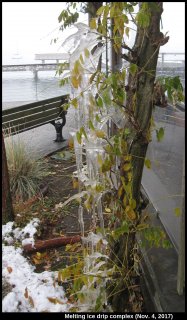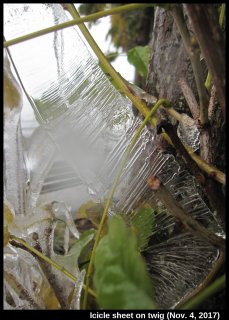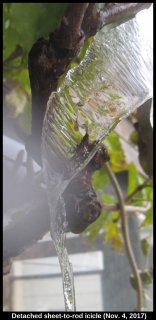| « Grain boundaries between crystals in big ice | The "Snow Candle" » |
Sheet icicles
On a bitter cold day in 2013, I was at a familiar cliff, climbing under a large rock ceiling. A little water had been seeping down through the crack above, forming an ice-filled crack that I had to dig out with my hammer to proceed. In a few spots, the water drips had detoured, meandering along the granite ceiling and freezing into very thin s-curved ribbons of ice. I'd never seen any drip formation so bizarre, or even seen a picture of anything like them. But my camera was far below, and I had to regretfully blast through the ice to proceed.
Recently I came across another thin, sheet-like ice formation on a small tree under a drip. In this case, the sheets followed a twig, and thus did not meander in s-curves. But they were similarly thin and sheet-like. Call them "sheet icicles". This time I had my camera handy.
Here's an overview of the drip formation.
And a close-up of one of the sheet icicles.
Note how you can look through the ice, almost like a window, indicating that the ice is thin (the corrugations clearly distort the clarity). But this ice is melting, not growing, and it has melted the most at the top, where the ice meets the warmer branch (which warms up in the sun). In fact, it is connected to the branch only at the ends of the sheet formation.
This detachment from the branch is even more pronounced in the case below.
Not seeing it form, I can only guess at the formation process. It seems likely that the drips flow along the underside of the branch, and freeze where it is colder, forming a rim of ice under the branch. Subsequent drips may flow along the previously frozen rim, also freezing there and thus extending the rim lower. But the water likely flows down the thin sides from the top as well (as occurs for the standard, pointy icicle), also freezing at the bottom rim. This flow down the side may help explain the apparent ribs coming down the side. These ribs slant, even "going uphill" near the bottom. Yet there is also a pronounced thickening at the bottom edge. So, clearly, the process is not trivial and deserves more observation and study.
Students of icicle formation may already realize that even the basic cone-shaped, pointy icicle is a very complicated system to accurately model and understand in detail. This sheet type is likely even more complex, and given its less-common nature, may require more strict conditions to form.
-JN


